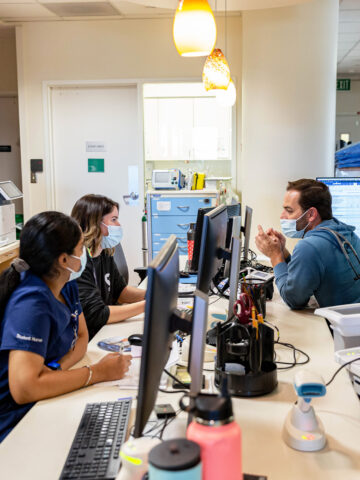Visiting a provider’s clinic or the hospital for emergency medical care, surgery, treatment or even a routine wellness appointment can often be scary and nerve-wracking for patients and their families.
Thankfully, the professionally trained child life specialists at The Cherese Mari Laulhere Child Life Department at CHOC work with providers and families to normalize the healthcare experience for kids by helping prepare for surgeries, providing education and support and much more.
In honor of March’s Child Life Month, Christy Campo, clinical educator, and Lauren Schwarz and Shayli Anderson, child life specialists, offer simple strategies that providers can use to put their patients and families at ease during their time treatment or visit to CHOC.
Why is visiting the doctor’s office or hospital scary for some kids?
Kids of all ages might have a fear of the unknown; they may have stranger anxiety about not knowing a provider or what may happen during their appointment, treatment or surgery. Additionally, the most common medical fears for kids are pain and needles — whether it be receiving treatment, vaccines or an IV.
Child life specialists recognize how age and development may impact the fears of children regarding medical care, says Lauren. For younger children, their greatest fear may be having to be separated from their parents during treatment. For older children, it could be having their body image negatively impacted by an illness or treatment.
Why is it important for kids to have positive interactions with medical providers?
When it comes to seeking necessary medical treatment, fearful kids can grow into fearful adults, says Christy. It’s important for children to have positive experiences with medical care when they are young so they will be open to seeking medical care in the future.
What can providers do to help put their patients at ease?
Although many providers have their own special ways of creating a positive experience for their patients, child life offers some simple strategies that providers can use for inspiration when relating to patients:
Build rapport and trust
Rather than being tempted to immediately start speaking about medical terminology, a diagnosis or treatment, start your experience with a patient by spending a few minutes getting to know them. Ask them a few questions about who they are and what they like to do. You could ask them about a toy or t-shirt, or anything that may spark unthreatening conversation, says Shayli.
Try to match your enthusiasm with your patient’s, says Lauren. If a patient is cheerful, try to be cheerful; if a patient is more quiet and mellow, try to be mellow. These strategies can help the patient feel comfortable and alleviate anxiety for the patient and their parent.
Also, consider getting on your patient’s level. It can be scary for kids to be lying in a hospital bed or on an exam table with providers and parents towering over them. Kneel or sit next to your patient in a chair so you can see them eye-to-eye.
Give your patient simple choices
Let your patient take some control over their appointment by letting them make simple choices. You could ask your patient if they would like their ears or eyes checked first; if they would like their chest or back listened to with the stethoscope first; or if they would like to sit on the exam table or with their parent.
By offering these choices, you can help your patient feel included and confident about their appointment.
Let your patient know what to expect
Much of a young patient’s anxiety surrounding a medical visit may be due to fear of the unknown. Because of this, walk your patients through the process of their appointment, exam or treatment. Simplify any medical terminology so patients can understand; show them any equipment you may use; and demonstrate an exam or treatment on the patient’s parent or stuffed animal.
Establish a team mentality
If a child is scared and upset, validate their feelings. Make sure that they know that you and their parents or guardians are working together with them to make sure they get better and are healthy. It’s important to work with parents or guardians as a team with one common goal: to protect the health and well-being of all children!
Open the conversation for questions
An exam, diagnosis or treatment may be overwhelming for both parents and their children. Instead of asking, “Do you have any questions?” Try asking, “What questions do you have?”
This encourages an open conversation for questions and can encourage parents and kids to ask questions, says Shayli.
Access resources
When a family is struggling during treatment — whether it be emotionally, financially or relationally — they can be assured that CHOC works as one strong team. Providers can reach out to resources like social services and child life to help families that are struggling. At CHOC, we not only care about our patients’ health, but we care about how they are doing in all aspects of life.
Providers at all of CHOC’s units and clinics are encouraged to reach out to child life anytime for additional support.
Learn more about the Cherese Mari Laulhere Child Life Department at CHOC




